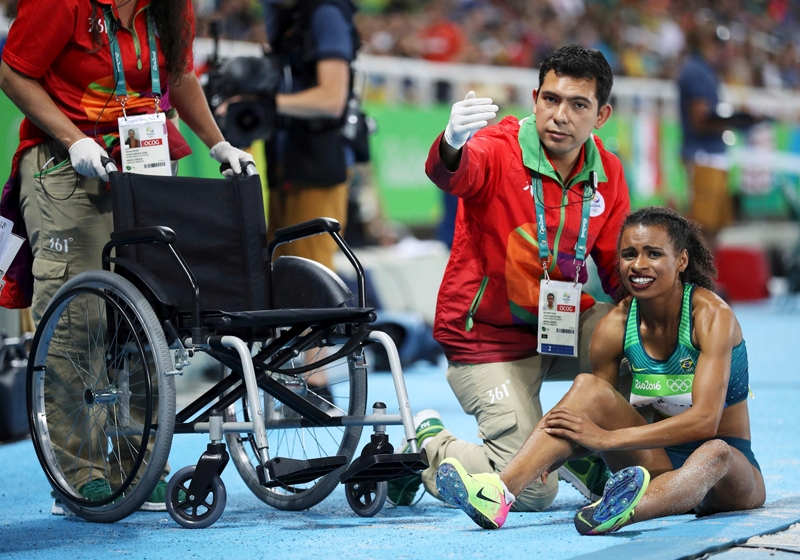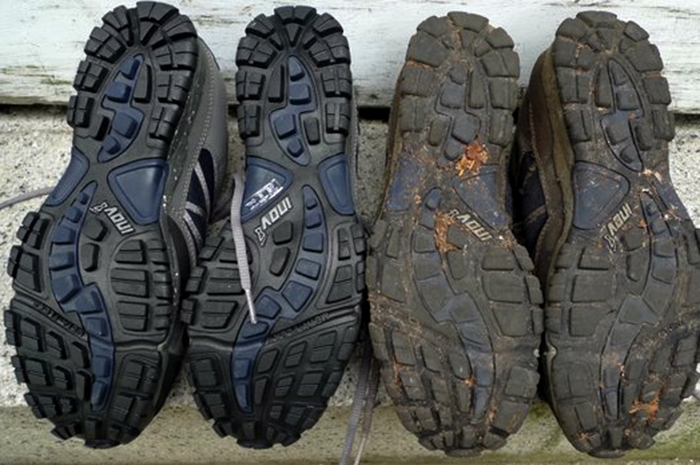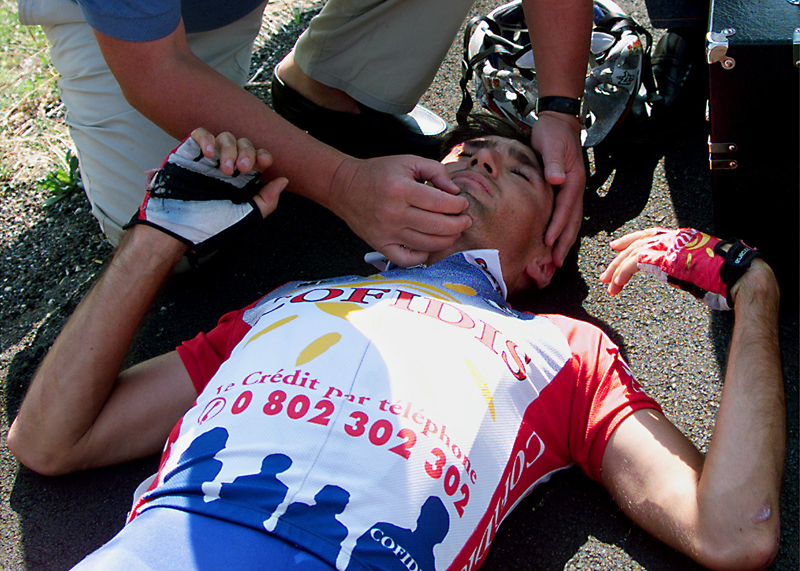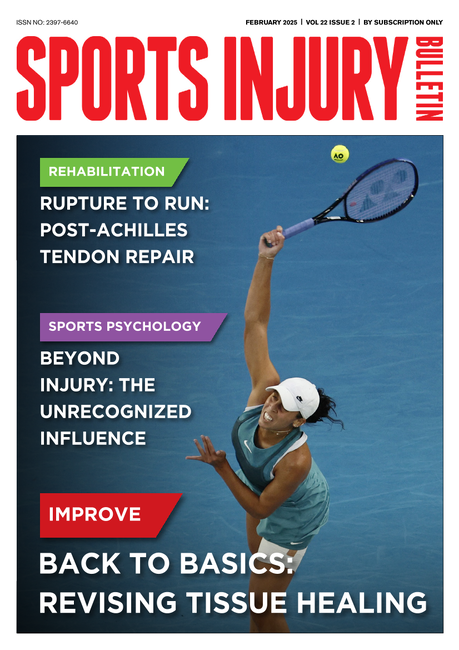You are viewing 1 of your 1 free articles. For unlimited access take a risk-free trial
Injury prevention: what can orthotic inserts do for you?
Can orthotics help runners and other endurance athletes? Alicia Filley examines the indications for orthotics use, and what the science says about their effect on performance
Runners’ feet take a pounding, often enduring large forces for hundreds of miles per year. For this reason, up to 70% of runners will experience some sort of chronic injury in a single yearJ1.Clin Biomech. 2006 Jul;21(6):623-30. Skeletal misalignment is a commonly implicated cause of such injuries and the theory is that orthotics (shoe inserts) can be prescribed to correct skeletal misalignment in the feet. Once only used by those with severe malformations or disabilities, today’s orthotics can be purchased over-the-counter and used by anyone – including runners who believe they may benefit.Trail of footprints
In order to understand the how and why of orthotics, we need to appreciate the general way feet function. Taking a foundational view of the body, proper skeletal alignment begins at the feet. When a child gets out of the swimming pool and pads across the concrete, the little prints left behind say a lot about their skeletal development. The same is true for an adult.Prints that are fat and pudgy indicate over-pronation, commonly called flat feet. Long and skinny prints signify oversupination, or a ‘high arch’ (see figure 1). In the over-pronator, the calcaneus, or heel bone, angles outward in what most refer to as eversion. For the over-supinator, the calcaneus angles inward in inversion. The calcaneus moves throughout a certain range of eversion to inversion during the gait cycle. Movement beyond that normal range results is over-pronation and over-supination.
Figure 1: Calcaneal alignment

Decisions, decisions
Historically, physicians developed shoe inserts to correct skeletal alignment. Today’s orthotics come in three types: prefabricated, semi-custom, and custom. Each of these can be rigid, semi-rigid, or flexible. Shoe stores and pharmacies sell prefabricated orthotics. Usually quite flexible, they may require trimming with scissors to fit in the shoe (see figure 2). This kind of orthotic generally fits most foot types, provides the least amount of control, but costs less than the others.Semicustom orthotics require a physiotherapist, trainer, or orthotist to chose the best-fit from a library of options, and adjust them. This is the next most cost and time-effective choice. Athletes can use them as a standalone product, or as a trial for a custom orthotic.
To fit a custom foot orthotic (CFO), an orthotist, pedorthist, or podiatrist first makes a mould of the athlete’s foot, from which to make the custom insert (see figure 3). Custom foot orthotics provide varying degrees of flexibility and firmness, based on the materials used and the needs of the individual. Athletes can pay upwards of £350 to £450 ($400 to $600) for a pair of CFOsJ Am Podiatr Med Assoc. 2008 Sept;98(5):394-403. New 3-D printing technology however may help to make orthotic customisation more readily available. In this application, professionals scan the foot, upload the results into a computer, customise the orthotic based on the scan; and then print the orthotics, making the process much faster (see figure 6).
FIGURE 2: PREFABRICATED, TRIMMABLE ORTHOTICS

FIGURE 3: CUSTOMISABLE ORTHOTICS

Do they work?
Researchers at the University of Massachusetts studied the effect of CFOs on 15 healthy female runners who demonstrated normal foot motionJ1.Clin Biomech. 2006 Jul;21(6):623-30. Although each orthotic was uniquely different, the authors attempted to achieve commonality by over correcting the position of the calcaneus and set all to five degrees of inversion while standing.Their findings indicated that the orthotics significantly reduced calcaneal eversion when compared to running in a shoe alone (without a custom orthotic). The actual finding was about a one-degree reduction in eversion; but keep in mind, these runners did not over-pronate to begin with. Functionally, this reduction could be larger in a runner who tended to over pronate. The results of this study also showed that the custom orthotic reduced the eversion velocity in the rear foot. This is important because slowing down how fast the foot rolls over during the gait cycle impacts how far it goes. Reducing eversion velocity could therefore also decrease the risk of injuriesJ1.Clin Biomech. 2006 Jul;21(6):623-30.
Custom job
A study at the University of Delaware considered whether CFOs were necessary to achieve the same degree of control over eversion velocity, or whether cheaper, simpler semicustom orthotics were equally as effective. Researchers analysed the gait of nineteen healthy runners while wearing CFOs, semicustom orthotics, and shoes without orthoticsJ Am Podiatr Med Assoc. 2008 Sept;98(5):394-403. Each subject ran in all three conditions and the levels of resulting eversion were compared.Subjects experienced the largest reduction in rear foot eversion while wearing custom orthotics; but this reduction was not significantly different from the slightly smaller decrease with semicustom orthotics. In fact, it wasn’t significantly different than while wearing the shoe alone. Only the reduction in eversion velocity achieved by both orthotic conditions reached a level of statistical significance.
The study also evaluated the comfort of each condition. Athletes found the CFOs generally more comfortable than the semi-custom, but not significantly. When asked about comfort in specific areas, runners found the semicustom significantly less comfortable in the medial arch (foot arch). In all other measures of both comfort and control, there were no significant differences. Therefore, healthy athletes may find that using a semicustom orthotic is just as good as a custom one in controlling rear foot motion, but without the delay in fabrication or the expense.
Forces for good
Investigators at the University of Calgary wondered what effect controlling rear foot motion has on function. Their subject review concluded that the skeleton only slightly changes its desired path of movement when constrained by an orthoticMed Sci Sports Exerc. 1999 Jul;31(7 Suppl):S421-8. Therefore, they propose that orthotics function mainly to filter ground reaction forces, provide increased sensory input to the foot, and support the skeleton’s desired path of movement. These, they further hypothesise, reduce the muscle activity required for movement. When the muscles don’t have to work as hard, the motion feels more comfortable and the strain on the muscles decreases. Reduced strain can help diminish the risk of chronic injury, and relieves muscles enough for the body to repair already damaged tissue.Two studies attempted to verify the theory that orthotics reduce muscle strain. The first, conducted at the University of Central Lancashire, evaluated the Achilles tendon load in 12 healthy male recreational runners running with and without prefabricated orthoticsClin Biomech. 2014 Sep;29(8):956-8. The findings showed that running with orthotics reduced Achilles tendon load when compared to running without them.
The second study, conducted at the same university, evaluated the effects of a prefabricated, semi-custom, and no orthotic on the Achilles tendon load in 12 healthy female runnersBaltic J Health Phys Activity. 2016;8(4):7-15. In this study, the orthotics made no difference whatsoever in the load experienced by the Achilles tendon while running, despite the fact that they used the same kind of prefabricated orthotic in both studies (see figure 2). In addition, they measured the forces experienced at the patellofemoral joint in the knee and found both types of orthotics increased the load at that joint (see figure 4). Therefore, these researchers concluded that using orthotics may actually predispose healthy female athletes to injury.
The lab at the University of Central Lancashire went on to measure the strain in the plantar fascia (the main muscle in the base of the foot) in 15 healthy male runners, both with a semi-custom orthotic and withoutFoot Ankle Online J.2015 Dec;8(4):5. They found that when running, the orthotic did not significantly effect the strain experienced by the plantar fascia. This result was surprising, especially given the fact that the orthotic in the study did reduce motion at the mid foot and rear foot. This finding supports the theory that other factors besides skeletal alignment influence stresses experienced in the foot.
FIGURE 4: ORTHOTIC USE AND LOADING AT THE KNEE JOINT

a. = patellofemoral force; b. = patellofemoral pressure
Black line = no-orthotic; grey line = semicustom, dashed line = off-the—shelf
The higher and wider peak shown by the grey line (semicustom) indicates increased knee loading compared to no orthotic (black line)
Placebo effect
Podiatrists at La Trobe University questioned if orthotics were effective clinically. They compared CFOs and sham orthotics in a population of 140 subjects with Achilles’ tendinopathyBr J Sports Med. 2015:49:989-994. One group of randomly assigned subjects received sham orthotics and the other one, CFOs. Orthotics are a common treatment strategy for this diagnoses, in the belief that they relieve the stress on the Achilles tendon. Both groups also received instructions for a home programme of eccentric calf muscle exercises.Researchers followed the study participants every three months for a year. Both the groups showed improvement in areas of pain, function, and activity level, at all follow ups. The stunning finding was that there was absolutely no difference in the amount of improvement between the groups at any point in the study. Neither was there a significant difference between the groups in the adverse effects reported from wearing the inserts.
This study shows that the effect on Achilles loading from an orthotic appears negligible, and raises the question of the placebo effect from the inserts. In other words, the expectation of an improvement in performance from wearing orthotics might be more important than any anatomical changes to foot motion in determining whether there is an improvement!
Similarly, surprising discoveries were made by a team at the University of Edinburgh when they evaluated 12 subjects (all with a history of Achilles’ tendinopathy) while running with and without CFOs. Nine of the 12 participants, a statistically significant number, demonstrated an increase in calcaneal eversion when running with a CFO. This despite the fact that they were customised by a podiatrist (and confirmed by a corroborating podiatrist) to decrease eversion! To add further confusion, 10 of the 12 subjects reported an average of 92% improvement in symptoms while running with the CFO (you would have expected symptoms to get worse if they increased eversion rather than decreased it). This study then questions the theory that its the motion-control properties that make orthotics clinically effective.
One explanation is that the orthotics caused relief in both studies because they provided a slight heel lift. This lift may shorten the Achilles tendon just enough to prevent it from being irritated with every stride, thus giving it an opportunity to repair itself. Skeletal alignment, in this situation, may have nothing to do with it at all!
Case study: Paula Radcliffe

Running over a hundred miles per week for nearly two decades left world record holder Paula Radcliffe with a degenerative foot injury. The long-ignored stress fracture in her foot led to the collapse of her medial arch. Surgeons rebuilt the arch, but it was Achilles tendon pain that nearly side-lined her from her swansong running of the London Marathon in 2015.
Her ability to finish the farewell race, in a still enviable time, was attributed to consultations with British Athletics, her medical team, and a highly specialised orthotics company in Belgium, who used 3D printing and cutting edge materials to fabricate her orthotics. The Belgian orthotics specialist mentioned is Runners Service Lab, who had been assisting Radcliffe with custom-made orthotics since 1996. The fully customised orthotics supplied to her were constructed using data gleaned from a technique known as dynamic footscan pressure analysis, which was used to formulate a 3-D construction aimed at optimising her running biomechanics.
PRACTICAL RECOMMENDATIONS
The variety of orthotics available, from off-the-shelf to laser customisation, makes it difficult to standardise studies and come up with reliable protocols. Those studies where comparisons can be made, present conflicting evidence. Overall however, we can conclude the following:- *Semicustom orthotics may be just as good as fully customised orthotics for producing improvements in running gait and reducing the risk of injury because the evidence from lab studies is that they exert good control over alignment.
- *For the diagnoses which typically warrant an orthotic prescription (such as plantar fasciitis, Achilles’ tendinopathy and patellofemoral syndrome), fully customised orthotics do appear to provide extra comfort and influence healing. However, some caution is required because the evidence suggests that they may also increase knee-loading forces, which in theory could increase injury risk.
- *Orthotics are still a necessity to compensate for skeletal deformity, actual (not apparent) leg length discrepancy, and some medical diagnoses.
- *Start with a reputable brand of prefabricated inserts rather than an unknown or poor quality make.
- *Watch out for any adverse affects. These may appear straightaway – eg blisters - or come on more gradually, such as aches, pains or unusual stiffness. Remember, orthotics have the potential to change things that don’t need changing, therefore they could put you at risk for new injuries.
- *If you want to try a custom orthotic, find a professional who specialises in biomechanical or athletic applications. Those specialising in medical orthotics are less likely to have the necessary knowledge or skills to produce a sportspecific orthotic.
- *Before investing in orthotics, try and eliminate other causes of pain/injury etc. The relationship between overpronation, over-supination, and overuse injuries is associational, not causal. That means while foot misalignments during running may contribute to chronic injuries, there is probably more to the story. Getting an assessment from a physiotherapist prior to visiting an orthotic specialist may therefore be useful.
Newsletter Sign Up
Testimonials
Dr. Alexandra Fandetti-Robin, Back & Body Chiropractic
Elspeth Cowell MSCh DpodM SRCh HCPC reg
William Hunter, Nuffield Health
Newsletter Sign Up
Coaches Testimonials
Dr. Alexandra Fandetti-Robin, Back & Body Chiropractic
Elspeth Cowell MSCh DpodM SRCh HCPC reg
William Hunter, Nuffield Health
Keep up with latest sports science research and apply it to maximize performance
Today you have the chance to join a group of athletes, and sports coaches/trainers who all have something special in common...
They use the latest research to improve performance for themselves and their clients - both athletes and sports teams - with help from global specialists in the fields of sports science, sports medicine and sports psychology.
They do this by reading Sports Performance Bulletin, an easy-to-digest but serious-minded journal dedicated to high performance sports. SPB offers a wealth of information and insight into the latest research, in an easily-accessible and understood format, along with a wealth of practical recommendations.
*includes 3 coaching manuals
Get Inspired
All the latest techniques and approaches
Sports Performance Bulletin helps dedicated endurance athletes improve their performance. Sense-checking the latest sports science research, and sourcing evidence and case studies to support findings, Sports Performance Bulletin turns proven insights into easily digestible practical advice. Supporting athletes, coaches and professionals who wish to ensure their guidance and programmes are kept right up to date and based on credible science.












